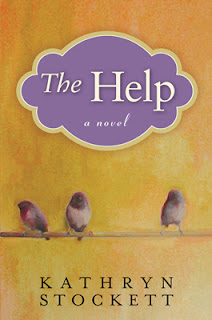I read this book mainly because Larry Brooks is doing a deconstruction of it. So, before reading his deconstruction, I'll do my own according to Brooks' six core competencies.
Structure: The first plot point, where Skeeter decides to write a book about the colored maids, was right were it was supposed to be at 25%. But the next 62% of the book drifted, some of it increasing the stakes--which were not strongly set up in the first quarter of the book--but most of it detailing the lives of Skeeter, Minny and Aibileen without a clear indication of how it connected to Skeeter's writing of the book. The lack of focus in this section made it tedious to get through. Then, at 87%, the book was published and things picked up which made the last part of the book a pleasure to read.
Writing Voice: The book is written in first person from the point of view of three different characters. It works. But it is also written in a mix of past and present tense which doesn't work and is a distraction. The story is clearly told as something that happened in the past, so why use the present tense except as a gimmick? (For a book where present tense was used well, see Calumet City.) Finally, the use of bad grammar while writing from the point-of-view of Aibileen was distracting and made it difficult to read. It was probably a mistake to start the novel this way and could explain why the book was rejected 45 times before being accepted. The bad grammar was unnecessary and a distraction.
Character: The characters of the two colored maids, Minny and Aibileen, were well done and interesting. However, the main character, Skeeter, was not shown as having strong motivation. The stakes for her were not well developed so her part was not as interesting.
Concept: What if a book showing the point-of-view of the colored help was published at the height of the Civil Rights Movement? This is a good concept, but it could have been executed better by having the plot focused more on the consequences of writing the book. How about making Skeeter fall in love with the senator's son and force her to choose between publishing the book and marrying the man she loves? Instead, her romance with Stuart was only loosely connected to the concept and did not increase the stakes.
Theme: The theme seems to be that colored maids are people too. Well, duh! If this book actually were written in the sixties at the height of the Civil Rights Movement, it would indeed have been important. But in 2011, when the President of the United States is black, this theme doesn't cut it.
Scene Construction: The scenes were well done. The first person narrative was effectively used to get us inside the head of the narrator and make the scene come alive.
Overall, I liked The Help, but mostly for the last part of the book where the consequences of the publication unfolded. I think the best executed elements of the book were character and scene construction, especially when it came to Minny and Aibileen. I think these elements are what people responded to and made it a best seller. Larry Brooks has a tendency to take best selling books and assume that they have perfect structure since they are best sellers. I think The Help is a good example of where the structure is merely adequate but where other elements are strong enough to make up for it.
Saturday, August 6, 2011
Subscribe to:
Post Comments (Atom)

No comments:
Post a Comment